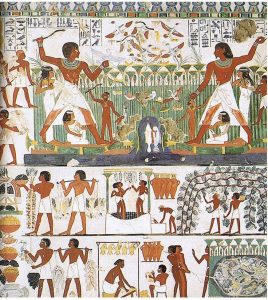Though Egypt Hunting and Fishing were very popular activities in ancient Egypt, fish behavior and reproduction remained a mystery to the ancient Egyptians: seeing mouth breeders spitting out their fry they thought that they were giving birth.

Fishing rods were generally not used, nor were floats alerting the angler to a catch. Instead, the fisherman supported the line with his outstretched index finger, feeling even the smallest tugs at the bait. The end of the line where the hooks were appears to have been weighed down, possibly with a lump of clay.
Fish was a fairly common element of the Egyptian diet, despite the fact that they were often considered to be unclean by wealthy nobles, and priests were not allowed to eat it. From the skins of seals, the Inuit people made kayaks, clothes, and footwear.
Hunting could be an extremely dangerous sport due to the wild nature of the animals which were hunted. The Ancient Egyptians used hunting dogs to help them capture their prey.
If the hunter wanted to make sure of his hunting success, he would build an enclosure of nets and posts; he would then drive the animal into it, and finally kill the poor animal for leisure.
Hunting expeditions of the pharaohs resembled often military campaigns more than pleasure outings. When big game hunting the king was accompanied by soldiers wearing full military gear, as was the king himself in his chariot. Thutmose III went elephant hunting near Niy in the Euphrates valley.
Papyrus boats were useful for hunting or crossing short stretches of water, using a paddle or a pole. These boats were made of bundles of bound papyrus reeds, and were lashed together into a long thin hull form in the style of a slight crescent.
Egypt Hunting and Fishing was the most important contributor to the human food supply; meat was a staple in the Inuit diet. Some animals were taken alive to be used as offerings to the gods. These were kept in zoos.